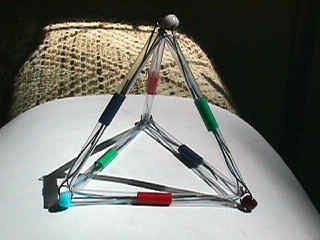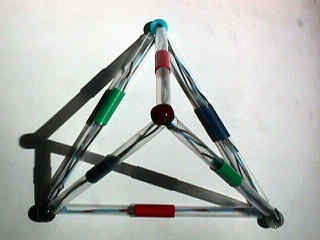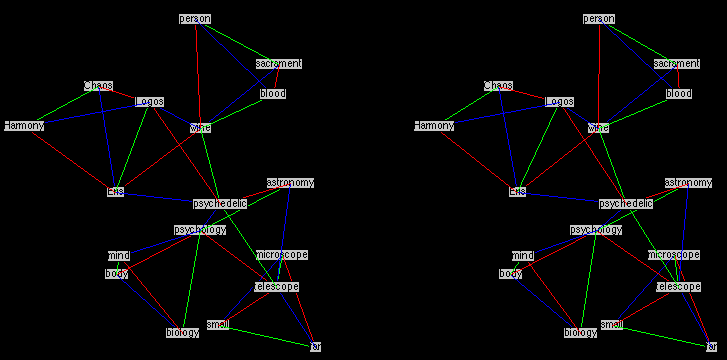![[Home]](https://ludism.org/logo/beads.gif)
Last edit
Changed:
< One night I was playing with the idea of trinities and quaternities in Kennexions. The [http://home.earthlink.net/~hipbone/IDTWeb/Ancient.html ancient Christian diagram of the Trinity], as seen on the Hipbone Games pages, is in fact a plane projection of a tetrahedron. I thought of the many quaternities represented by tetrahedra in Rudy Rucker's book ''Mind Tools'', Jung's quaternities, including (Trinity+Mary), and (most importantly) R. Buckminster Fuller's obsession with the tetrahedron...
to
> One night I was playing with the idea of trinities and quaternities in Kennexions. The [https://hermetic.com/hipbone/ancient ancient Christian diagram of the Trinity], as seen on the Hipbone Games pages, is in fact a plane projection of a tetrahedron. I thought of the many quaternities represented by tetrahedra in Rudy Rucker's book ''Mind Tools'', Jung's quaternities, including (Trinity+Mary), and (most importantly) R. Buckminster Fuller's obsession with the tetrahedron...
One night I was playing with the idea of trinities and quaternities in Kennexions. The ancient Christian diagram of the Trinity, as seen on the Hipbone Games pages, is in fact a plane projection of a tetrahedron. I thought of the many quaternities represented by tetrahedra in Rudy Rucker's book Mind Tools, Jung's quaternities, including (Trinity+Mary), and (most importantly) R. Buckminster Fuller's obsession with the tetrahedron...
Something had to come out of this tetrahedron stew, so I asked myself, "Why wouldn't a kenning analogy, which has four terms, fit onto a tetrahedron?"
I quickly built a tet with drinking straws and rubber bands, based on a modelling technique Karl Erickson had shown me. I taped up each strut, and coloured the tape red, green, and blue according to which strut it was on (more in a minute). I looped telephone wire through the beads you see and stuck each leg of the leftover wire down a straw.
I call the result a "kentet abacus" (Fig. 1). "Kentet" stands for "kenning tetrahedron" and recalls "quartet" and fourness. "Abacus" recalls Hesse's statement that the Glass Bead Game got its name from the early bead abacuses on which the games were played.
The kentet abacus in Figure 1 illustrates the following classical kenning analogy:
ship horse ---- :: ----- sea road
As you know, you can form kennings with the "across, then diagonal" strategy. Example: ship = sea horse. (Sea is across from ship, and horse is diagonal from sea.)
There are three basic sorts of links between the terms here: accompanying (ship accompanies sea, horse accompanies road), matching (ship matches horse, sea matches road), and zigzag (ship is zigzag from road, sea is zigzag from horse). For the purposes of the abacus, each has a colour (Table 1).
| Link type | Colour |
| (A)ccompanies | Blue |
| (M)atches | Green |
| (Z)igzag | Red |
Table 1: Link types and colours
This is a sort of Doppler scale; the closer the relationship between the terms, the shorter the wavelength of the colour. Also notice that A is the first letter of the alphabet, Z is the last, and M is the exact center. M for middle, etc.. (I used to have a lot of fun with this sort of "alphanumerology.")
I also assigned a bead of a different colour to each term in the kenning analogy (Table 2).
| Term | Colour |
| ship | grey |
| sea | blue |
| horse | brown |
| road | black |
Table 2: Bead colours for a classical kenning analogy
So, what you're looking at in Figure 1 is ship (grey) at the top, sea (blue) in the lower right, and horse (brown) at the lower left. Between ship and sea is a blue strut (Across), between sea and horse is a red strut (Zigzag), and between horse and ship is a green strut (Matching).

Fig. 1: Ship = sea horse kenning, left-handed
To make a kenning for a term, all you have to do is follow its blue strut to the first part of the kenning, and then follow the red strut to the second part. This works for every kenning -- it's the old "across, then diagonal" trick again. You can see that you have to go clockwise. I call this a left-handed kenning abacus, because you read the kenning from right to left.
It is possible to construct right-handed kenning abacuses too, in which the kennings read properly from left to right and you move counterclockwise to construct them (Fig. 2). Figure 3 shows the same right-handed kentet abacus displaying a kenning for "horse", and Figure 4 shows a top view of the same abacus.

Fig. 2: Ship = sea horse kenning, right-handed

Fig. 3: Horse = road ship kenning, right handed

Fig. 4: Top view of right-handed kentet abacus
After I had turned these models in my hands a little while and meditated on them, I felt I understood a little of how kennings become tetrahedra. I took the geometric/memetic modelling tool called Struck (now being rereleased as Fluidiom), and rendered a model of the PsychedelicGame?, the very first game ever composed in Kennexions (see KennexionsIntroduction).
Following are links to some pictures of the Psychedelic Game as rendered in Struck. You can cross your eyes and see these structures in three dimensions if your screen is wide enough. (The pictures will have black backgrounds if they load correctly.)
First view:

Second view:

I found something surprising: the game composition, which seems so symmetrical and harmonious in text, is actually slightly asymmetrical when rendered graphically. Notice the link between Logos and Eris. This is called an edge bond; that is, their respective tetrahedra are joined along an edge. All other bonds in the game are vertex bonds; that is, their tetrahedra are joined at the vertices.
Well, I was expecting something surprising, so perhaps this isn't so surprising in retrospect. It would have been surprising had I gained no new information.
And the disharmony? The game is about Eris, after all...